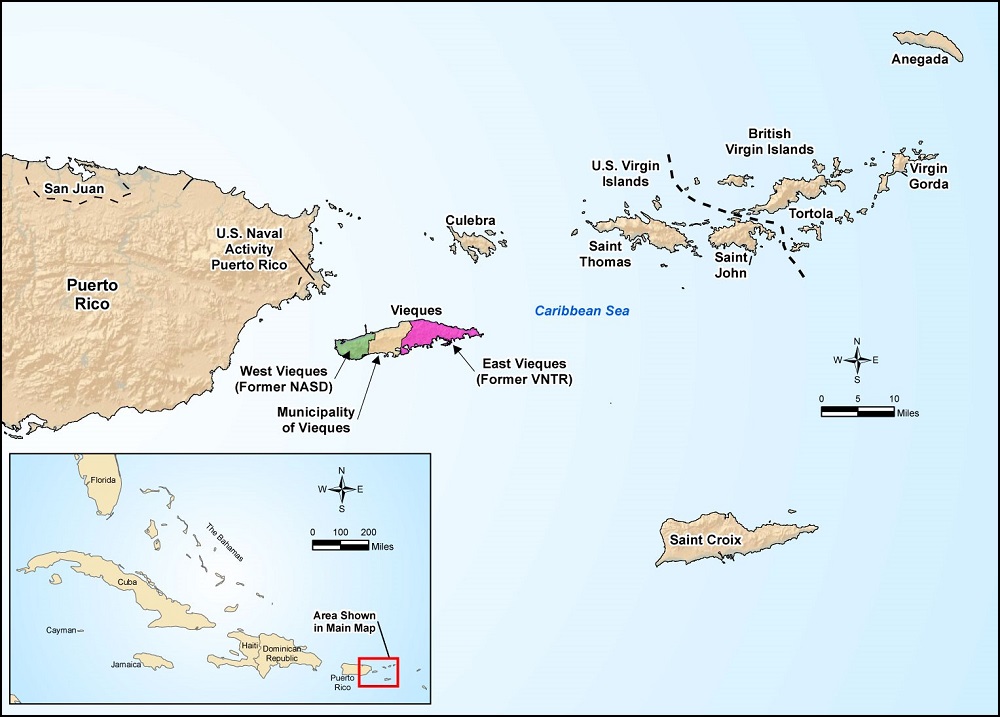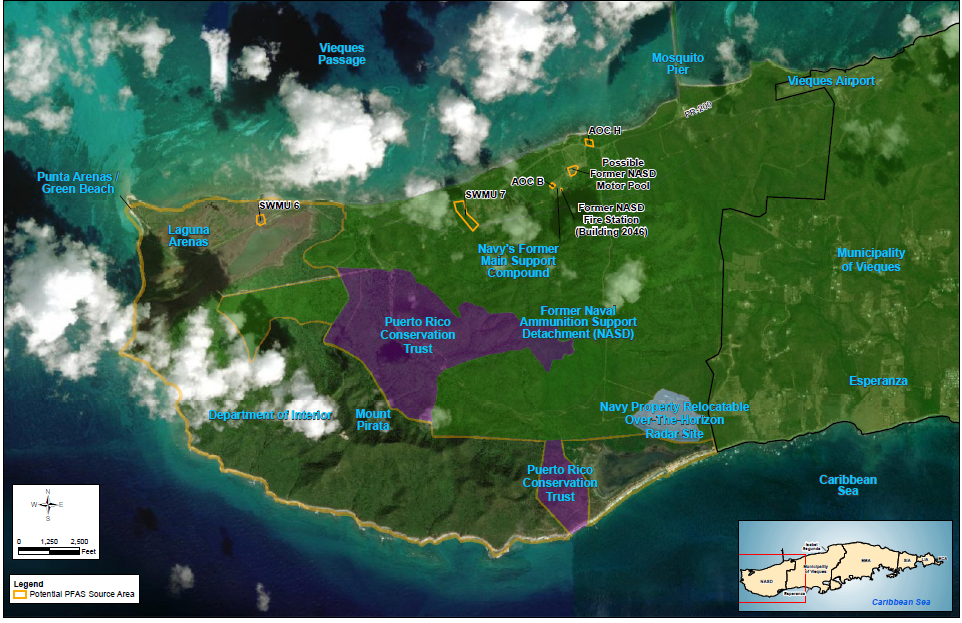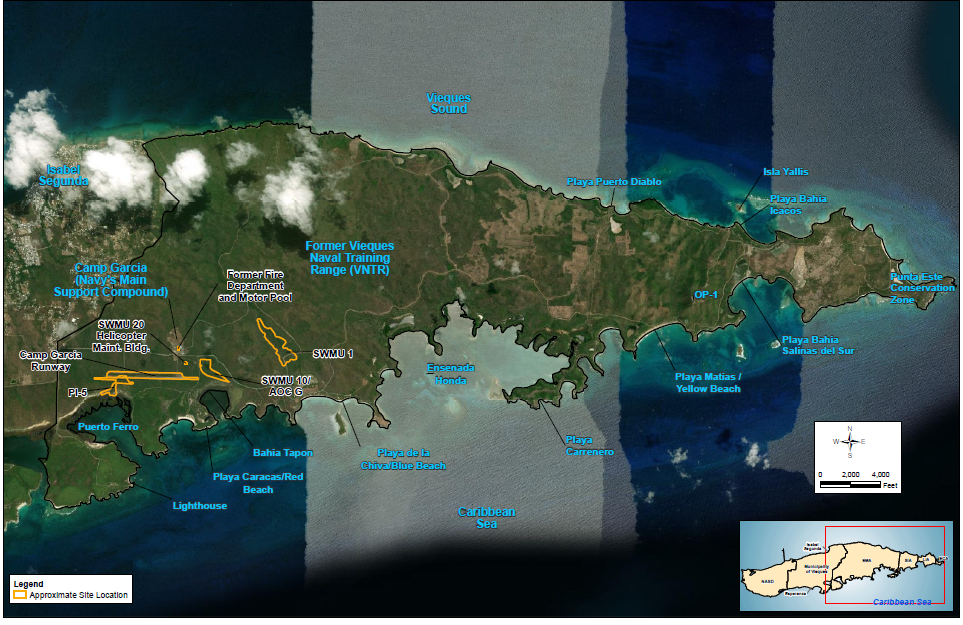Vieques
Vieques Island has a land area of approximately 33,000 acres and is located in the Caribbean Sea approximately seven miles east of the main island of Puerto Rico (Figure 1). Early in the 1940s, the Department of the Navy (Navy) purchased large portions of Vieques to conduct activities related to military training. The former Vieques Naval Training Range (VNTR), located on the eastern half of the island, was used for various aspects of naval gunfire training, including air-to-ground ordnance delivery, amphibious landings, and housed the main base of operations at Camp Garcia for military training and support activities. The former Naval Ammunition Support Detachment (NASD), which was located on the western half of the island, was used mainly for ammunition loading and storage, vehicle and facility maintenance, and open burn/open detonation activities. The communities of Isabel Segunda and Esperanza are located between the former VNTR and former NASD.
Figure 1: Regional Location Map

Background
Per- and Polyfluoroalkyl Substances
Per- and polyfluoroalkyl substances, commonly known as PFAS, are a family of thousands of different chemicals widely used in commercial and consumer products beginning in the 1950s to prevent stains and repel water, oil, and grease. PFAS have been used in a variety of products, such as stain-resistant carpet and upholstery, nonstick cookware, floor wax, food packaging, and firefighting foam. PFAS are now present virtually everywhere in the world because of the large amounts that have been manufactured and used by international consumers and industry. Once these compounds are released to the environment, they break down very slowly.
PFAS are chemicals of emerging concern, which have no Safe Drinking Water Act regulatory standards or routine water quality testing requirements. The USEPA is currently studying PFAS to determine if national regulation is needed and has issued a drinking water lifetime health advisory of 70 parts per trillion (ppt) for two commonly used and studied types of PFAS: perfluorooctane sulfonate (PFOS) and perfluorooctanoic acid (PFOA), individually or summed. Studies by the USEPA, the Agency for Toxic Substances and Disease Registry (ATSDR), and others indicate that exposure to PFAS may cause health effects. Individual states are also conducting their own evaluations and may establish their own drinking water standards or environmental cleanup requirements.
Navy and Marine Corps use of PFAS
While PFAS have been used in a variety of products and substances worldwide, the most common historical military use has been as a component of firefighting foam (specifically aqueous film forming foam, or AFFF) since the 1970s. In this formulation, AFFF has been used for testing, training, firefighting, and other life-saving emergency responses. The Navy is working to identify a new formulation for firefighting foam that does not contain PFOS and PFOA but will still meet critical fire suppression, and ultimately lifesaving, properties. Until this formulation is approved, and products are available, we have taken steps to prevent or minimize additional release of firefighting foam to the environment. These specific actions are explained in the PFAS Regulatory History and Navy Policy section of this webpage.
Identification and Sampling of Potential PFAS Release Areas at Vieques
In accordance with Navy policy to address past releases of PFAS at installations nationwide, a Preliminary Assessment (PA) was completed that evaluated the potential for PFAS to be present as a result of historic military practices conducted at the Atlantic Fleet Weapons Training Area (AFWTA) -Vieques (CH2M, 2020). Based on information contained in the PA Report, 13 areas were identified as possible AFFF or other PFAS-containing material source/release areas. Six of the areas within the former NASD (Figure 2) and seven areas are within the former VNTR (Figure 3). PFAS sampling will be conducted at each of the following areas as part of a Site Inspection (SI):
Former NASD
-
AOC H – Former Power Plant Fire Training Area
-
Former Fire Station Building 2046 at the Public Works Area
-
Potential Former Motor Pool Area
-
AOC B – Former Wastewater Treatment Plant
-
SWMU 6 – Former Mangrove Disposal Site
-
SWMU 7 – Former Quebrada Disposal Site
Former VNTR
-
Potential Former Motor Pool Area (including Building 340) and Former Fire Department Building 330
-
SWMU 20 – Former Helicopter Maintenance Area
-
Camp Garcia Runway
-
PI 5 – Surface Water Drainage Area from Camp Garcia Runway
-
SWMU 10 – Former Sewage Treatment Lagoons
-
AOC G – Former Sewage Treatment Chlorination Building
-
SWMU 1 – Former Camp Garcia Municipal Solid Waste Management Unit (Landfill)
These thirteen areas were identified during the PA as possible PFAS source/release areas because of: (a) the potential storage or use of AFFF for activities associated with fire-fighting readiness and training, (b) disposal of potential AFFF-containing containers or other materials, and (c) discharge or treatment of water potentially containing AFFF.
Both the PFAS PA Report and PFAS SI Quality Assurance Project Plan can be found in the Vieques administrative record (Online at: https://go.usa.gov/xRHxY). These documents detail the operational backgrounds of each site and the rationale for PFAS sampling. Sample collection at the sites is currently underway; this webpage will be updated with information gathered during the SI once all the data have been gathered, compiled, and evaluated.
Figure 2: PFAS SI Investigation Areas at the Former NASD

Figure 3: PFAS SI Investigation Areas at the Former VNTR

PFAS Regulatory History and Navy Policy
PFOA Stewardship Program
In 2006, USEPA initiated the 2010/2015 PFOA Stewardship Program in which eight major companies in the United States committed to reduce facility emissions and product contents of PFOA and related chemicals on a global basis by 95 percent no later than 2010, and to work toward eliminating emissions and product content of these chemicals by 2015. All U.S. companies have met the program goals. To meet the program goals, most companies stopped the manufacture and import of long-chained PFAS, and then transitioned to alternative chemicals. On January 21, 2015, USEPA proposed a Significant New Use Rule under the Toxics Substances Control Act to require manufacturers (including importers) of PFOA- and PFOA-related chemicals to notify USEPA at least 90 days before starting or resuming new uses of these chemicals in any process.
Unregulated Contaminant Monitoring Rule (UCMR)
The USEPA issued the Third Unregulated Contaminant Monitoring Rule (UCMR3)* in May 2012. The UCMR3 required all large public water systems (PWSs) serving more than 10,000 people and 800 representative PWSs serving 10,000 or fewer people to sample for 30 chemicals between 2013 and 2015. Six PFAS were included in the UCMR3 contaminant list. Of the six PFAS, USEPA issued health advisory levels for only two, PFOA and PFOS. The UCMR3 results found these two chemicals were present in less than 1 percent of the nearly 5,000 public water systems sampled per UCMR3.
In December 2016, the USEPA issued the Fourth Unregulated Contaminant Monitoring Rule (UCMR4). UCMR4 requires all large PWSs serving more than 10,000 people and 800 representative PWSs serving 10,000 or fewer people to sample for 30 chemicals between 2018 and 2020. There were no PFAS included on the UCMR4 list of contaminants.
A Fifth Unregulated Contaminant Monitoring Rule (UCMR5) went into effect on January 26, 2022. UCMR5 requires all PWSs serving more than 3,300 and a representative sample of 800 systems serving 3,300 or fewer people to sample for 30 chemicals (29 PFAS and lithium) between 2023 and 2025.
* The 1996 Safe Drinking Water Act (SDWA) amendments require that once every five years US EPA issue a new list of no more than 30 unregulated contaminants to be monitored by PWSs.
USEPA Lifetime Health Advisories
In May 2016, the USEPA Office of Water issued a drinking water lifetime health advisory for PFOA and PFOS. Health advisories are not enforceable, regulatory levels; rather, they are levels that provide the public, including sensitive populations, with a margin of protection from a lifetime of exposure to PFOA and PFOS in drinking water. The health advisory is 70 ppt for PFOA and 70 ppt for PFOS. When both PFOA and PFOS are found in drinking water, the combined concentrations of PFOA and PFOS are compared with the 70 ppt health advisory level.
Navy Policy
Department of the Navy, Office of the Assistant Secretary (Environment) [DASN (E)] Policy Memo, 21 Oct 2014
The Navy issued a policy requiring on-base drinking water sampling for PFOA and PFOS for bases where groundwater was used as drinking water and PFAS could have been released nearby in the past. Navy and Marine Corps installations that were not required to sample finished drinking water under UCMR3, that produce drinking water from on-installation sources and have an identified or suspected PFAS release within approximately 1-mile upgradient to the drinking water source were also required to sample their finished drinking water by December 2015.
Chief of Naval Operations (CNO) Policy Memo, 14 Sept 2015
Similar to the October 2014 DASN (E) policy memo, this memo related to testing on-base drinking water. However, this memo also specified that if levels of PFOS and/or PFOA in drinking water exceeded the current at the time USEPA health advisory (that is the 2009 provisional short-term health advisories), then alternative drinking water must be supplied until the PFOA and/or PFOS levels were reduced to below the USEPA health advisory.
DASN (E) Policy Memo, 14 Jun 2016
This policy expanded the sampling PFOA and PFOS at all DON installations where such sampling was not previously completed under USEPA’s UCMR 3 or the DON’s October 2014 policy. This memo also specified that for instances where drinking water from an installation is purchased from a public water system, but wasn't tested under UCMR3, that the installation must sample the finished drinking water to comply with this policy. Additionally, this policy included reporting requirements to the DASN (E) office for all PFOA and/or PFOS in drinking water results.
DASN (E) Policy Memo, 17 June 2016
This policy defines the DON’s intention to remove, dispose, and replace legacy AFFF that contains PFOS and/or PFOA once environmentally suitable substitutes are identified and certified to meet MILSPEC requirements. This policy directs the following actions be taken until suitable replacements are certified:
-
Immediately cease the uncontrolled environmental release of AFFF for shoreside installations, with the exception of emergency responses.
-
Update and implement Navy and Marine Corps firefighting system requirements, as needed, to ensure fire and emergency service vehicles and equipment at DON installations and facilities are tested and certified in a manner that does not allow the release of AFFF to the environment.
-
By the end of Fiscal Year 2017 (FY17), remove and dispose of uninstalled PFOS-containing AFFF in drums and cans from local stored supplies for shore installations and ships to prevent future environmental releases.
DASN (E) Policy Memo, 20 Jun 2016
This policy required the Navy and Marine Corps to identify and prioritize sites for investigation if drinking water resources, on- or off-installation, are thought to be vulnerable to PFAS contamination from past Navy and Marine Corps PFAS releases. Sites with drinking water sources within 1-mile downgradient from known or potential releases of PFAS were assigned the highest priority. This policy directed the sampling of off-base drinking water at these high priority (Priority 1) sites within FY17.
The primary mechanism to identify potential PFAS release sites and areas of concern (AOC), was review of Environmental Restoration records. To ensure that all potential PFAS release mechanisms were identified, installations were directed to review installations to identify areas that are not already part of the Environmental Restoration program. We have completed the sampling for all off-base potentially impacted drinking water sources that were identified as a result of this policy and currently known exposures have been addressed.
U.S. Marine Corps Policy
Marine Corps Bulletin 11000, 20 February 2020
This bulletin issues policy and assigns responsibility for a wide range of PFAS-related issues in the USMC, including, but not limited to drinking water sampling, disposal of PFAS contaminated materials, and procurement and management of AFFF stock.
Department of Defense (DoD) Policy
Secretary of Defense Memo, 23 July 2019
This memo established a PFAS task force to ensure a coordinated, aggressive, and holistic approach to DoD-wide efforts to proactively address PFAS. The goals of the task force are mitigating and eliminating the use of the current AFFF, understanding the impacts of PFAS on human health, and fulfilling cleanup responsibility related to PFAS. The task force is coordinating and collaborating with other federal agencies to achieve these goals.
ASD Memo, 23 October 2019
This memo revised quarterly progress reporting requirements for installations with known or suspected PFAS releases.
ASD Guidance Memo, 22 November 2019
This memo established requirements for installation commanders to conduct community engagement with respect to PFAS issues, report on their progress in so doing, and to provide feedback on community questions and concerns.
ASD Guidance Memo, 22 November 2019
This memo established a consistent methodology for analysis of PFAS in media other than drinking water and requires DoD Components to use analytical methods meeting the DoD/DOE Quality Systems Manual for Environmental Laboratories, Appendix B, Table B-15.
ASD Memo, 13 January 2020
This memo established annual reporting requirements for AFFF usage or spills (not associated with use) at all DoD installations.
ASD Policy Memo, 2 March 2020
This memo identifies requirements for PFAS drinking water sampling on DoD installations where DoD is the drinking water purveyor. The requirements include initial and routine monitoring, actions necessary if results exceed the lifetime health advisory, laboratory analysis and record keeping requirements, and notification of results.
ASD Policy Memo, 23 July 2020
This memo identifies requirements for drinking water testing for PFAS on DoD installations where DoD is not the drinking water purveyor. The requirements include coordination with the non-DoD drinking water purveyor, actions necessary if results exceed the lifetime health advisory, and notification of results.
ASD Policy Memo, 18 September 2020
This memo provides guidance for sharing drinking water monitoring data related to PFAS and other emerging contaminants between the DoD installations and municipalities or drinking water utilities that are one-mile downgradient of a release from a military installation where the release may migrate and impact the drinking water utility or municipality
ASD Policy Memo, 18 September 2020
This memo prohibits testing and training with fluorinated AFFF on all DoD installations, with the exception of the five installations listed in the memo and the pier side testing of ship's AFFF systems.
ASD Guidance Memo, 15 September 2021
This memo updates the 15 October 2019 ASD guidance memo by providing the updated PFBS screening values that can be used to estimate screening levels used in the CERCLA program to determine if further investigation is warranted in the remedial investigation (RI) or if a site can proceed to site closeout.
ASD Guidance Memo, 7 December 2021
This memo updates the 22 November 2019 guidance memo by requiring the use of USEPA’s Draft Method 1633 “Analysis of PFAS in Aqueous, Solid, Biosolids, and Tissue Samples by LC-MS/MS” for analysis of PFAS in matrices other than drinking water for all new contracts and task orders issued after December 31, 2021. Existing projects are encouraged to use this method when ELAP-accredited laboratories become available.
ASD Guidance Memo, 22 December 2021
This memo provides clarifying guidance on what triggers the need for removal actions under CERCLA and how DoD should address properly promulgated State PFAS drinking water standards as part of a CERCLA removal action.
Vieques-specific PFAS related Documents
Additional Documents
Links